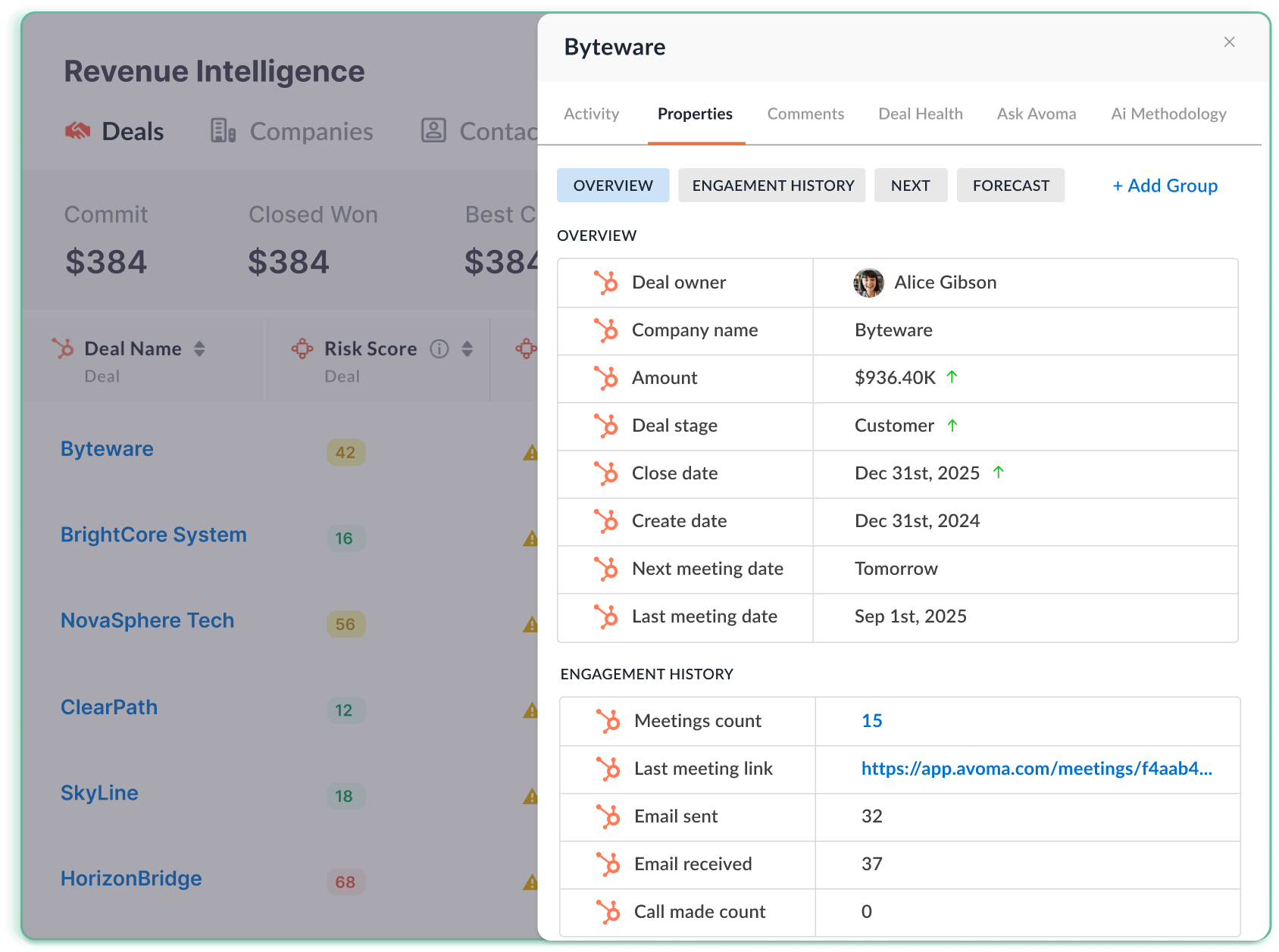Churn risk insights
Predict churn risk with revenue intelligence
Use real-time CRM updates, deal sentiment, and activity data to detect churn risk early before it derails retention goals


Trusted by Customer Success Leaders
Hidden churn triggers
Churn risk is easy to miss without unified signals. When CRM gaps and quiet accounts stack up, forecasts get crushed.

Missed disengagement signals
Inactivity post-sale often gets lost in siloed tools. No-shows, unanswered emails, and meeting lulls aren’t tracked or flagged.

Incomplete or inaccurate CRM data
Manual note taking is inconsistent, and reps often forget or skip updates. This creates a CRM filled with partial truths that erode forecast accuracy and hinder deal inspection.

Broken sales-to-CSM handoffs
Key deal context doesn’t transfer across teams. Handoffs miss red flags like pricing concerns or usage blockers.

Forecast blind spots
Without churn indicators, forecasts stay inflated. RevOps can’t model risk-adjusted retention in time.

Late coaching interventions
By the time a CSM flags risk, it's often too late. Managers lack context to coach proactively on early churn cues.

Untracked sentiment decline
No system tracks how tone, urgency, or hesitation change over time. These signals that precede churn.
Predict churn before it hits
Make churn prediction systematic with AI. Surface risk early, sync it to CRM, and act fast so churn never happens.
Real-time pipeline analytics
Automatically detect early churn signals like skipped QBRs, ghosted emails, and stalled decision loops. These silent red flags often precede cancellations but go unnoticed in traditional systems. Churn risk prediction tools analyze engagement drop-offs and bring them front and center.


Real-time pipeline analytics
Push churn-related signals like funnel stage regression, lack of stakeholder response, or shrinking deal teams into CRM in real time. Automating this layer of churn risk prediction gives RevOps and post-sale teams the context they need without relying on reps.


Real-time pipeline analytics
Score calls for subtle churn cues like long silences, soft objections, or vague next steps. These moments are early indicators that accounts are slipping. Coaching based on AI-powered churn risk prediction enables managers to intervene before renewal is off the table.


Real-time pipeline analytics
Ensure the context that matters pricing pushback, onboarding concerns, or late-stage friction makes it from sales to customer success. Automated chaptering supports churn risk prediction by preventing dropped information that could trigger dissatisfaction.


Real-time pipeline analytics
Layer churn prediction data into your pipeline and revenue forecasts. By integrating churn risk prediction into forecast models, RevOps can de-risk revenue projections and align GTM teams around more realistic retention assumptions.


Real-time pipeline analytics
Detect changes in tone, urgency, or buyer hesitation that suggest dissatisfaction. Real-time alerts powered by churn risk prediction keep teams ahead of cancellations enabling targeted re-engagement and proactive support.


The results speak for themselves, so do our customers.

_BestEstimatedROI_Small-Business_Roi.png)


FAQs
Get clear answers to your top churn risk questions
Churn risk refers to the likelihood that a customer will cancel their subscription or stop using your product/service In Avoma, churn risk indicators are identified through conversation analysis that detects negative sentiment, unresolved problems, competitive mentions, or usage concerns The platform helps customer success teams quantify these risks and take proactive steps to address issues before they result in lost business
Avoma helps with churn risk by providing early detection of potential customer issues through conversation analysis The platform identifies negative sentiment patterns, unresolved problems, competitive mentions, and usage concerns before they lead to cancellation This early warning system allows customer success teams to intervene proactively, address specific concerns, and create targeted retention strategies for at-risk accounts
Yes, Avoma helps with both retention and growth by providing insights for customer success and sales teams For retention, the platform identifies churn risks, ensures consistent service delivery, and captures product feedback For growth, it spots expansion opportunities within existing accounts, improves sales conversion rates, and accelerates new customer acquisition through more effective sales conversations
Yes. Avoma integrates with CRMs like Salesforce and HubSpot, automatically logging churn-related signals such as sentiment shifts, buyer disengagement, and stage stalls. This makes churn risk prediction visible across your entire revenue system.
Yes. Avoma’s Forecasting Tools incorporate churn prediction insights directly into pipeline views. This helps RevOps leaders identify which accounts may not renew and build more accurate, retention-aware revenue forecasts.
Avoma identifies risks that often go unnoticed in traditional systems. It detects negative sentiment, repeated complaints, lack of product adoption, missed expectations, and signs of disengagement. It can also flag mentions of competitors, delayed decisions, and unresolved action items. These signals help CS teams prioritize at-risk accounts before churn becomes inevitable.
Yes. Repeated negative sentiment in calls from either reps or customers can be a signal of disengagement, friction, or dissatisfaction. Avoma helps surface these patterns before they become churn events.
Yes. Avoma automatically tags and groups recurring feedback across calls, making it easy to report on product gaps that could influence retention.
Yes. Avoma helps teams identify at-risk accounts before churn happens. Its real-time insights into engagement patterns and sentiment trends allow customer-facing teams to re-engage accounts early, making churn risk prediction a proactive process.
Avoma improves customer engagement by ensuring consistent follow-through on commitments, providing deeper understanding of customer needs, and identifying engagement opportunities The platform helps customer-facing teams prepare for calls with complete context from previous interactions, surfaces product usage insights that can drive value discussions, and ensures action items are captured and addressed promptly, creating more meaningful customer relationships


What's stopping you from turning every conversation into actionable insights?


%20(1).png)
%20(1).png)
.png)
%20(1).png)
%20(1).png)
%20(1).png)
.webp)
%20(1).png)




